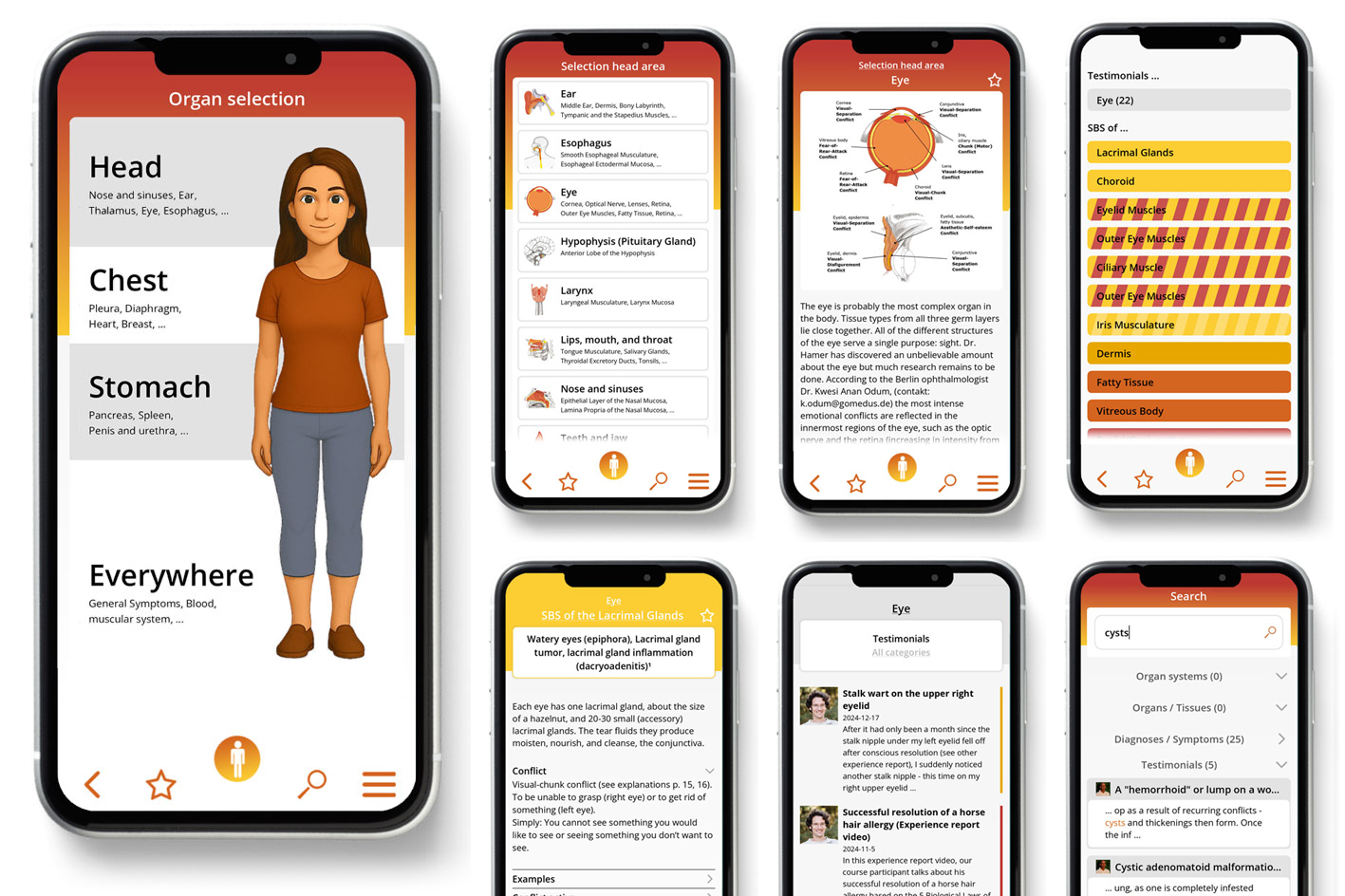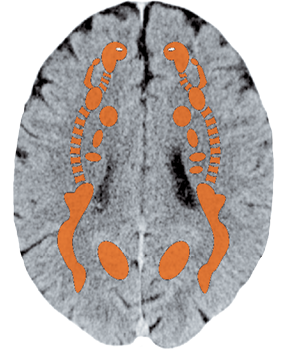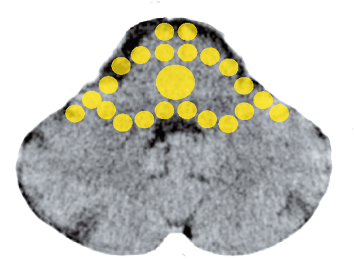 The information on this site is from one of the most famous books about the New Medicine (GNM / 5BN): "The Psychic Roots of Diseases" by Björn Eybl. Since September 2025, it is available in the form of an app with many additional features.
The information on this site is from one of the most famous books about the New Medicine (GNM / 5BN): "The Psychic Roots of Diseases" by Björn Eybl. Since September 2025, it is available in the form of an app with many additional features.It was written in german and was translated into more than 10 languages already. German is not freely available, as the rights are held by a publisher, but all these translations are available as ebooks / PDFs for free, as a gift of Björn for you, for the New Earth, for a new time.
In cooperation with Björn, it is splitted on "Disease is Different" into the sections by organ systems and combined with the real cases of our international testimonial / report archive of the related organ system.
ADRENAL GLANDS
The adrenal glands (glandula suprarenalis) are paired hormone glands located at the poles of the kidneys. According to Dr. Hamer, the stress hormones dopamine, noradrenaline, and adrenaline, are produced in the endodermal adrenal medulla. From the base substance cholesterol, the mesodermal adrenal cortex produces cortisol and aldosterone (also stress hormones) and male sex hormones.
Adrenal Medulla
Too much stress

Adrenal Cortex
Conflict, being off track,
wrong path in life
SBS of the Adrenal Cortex

Chronic Fatigue Syndrome (CFS), hypofunction of the adrenal
cortex (adrenal gland insufficiency, Addison‘s disease), reduced blood sugar1
| Conflict | Being thrown off course, taking the wrong path or having “bet on the wrong horse.“ Having made a wrong decision. Being on the wrong track/having fallen into the wrong hands. |
|---|---|
| Examples | ➜ Distracted, an antelope loses contact with the herd (= mortal danger, start of the AC-SBS). Running further in the wrong direction, this program becomes active — it becomes tired. However, if by chance it runs in the direction of the herd, the brake is released — the cortisol turbo kicks in — and it gallops ever faster in the right direction. > In this way, it has the best chance of finding the herd again. The young woman grows up in a sheltered environment. Due to marriage and quickly having three children, she finds herself in a difficult situation: The children keep her busy constantly and, in her opinion, her husband does not pay enough attention to her. It gets to the point where the partnership is in doubt = conflict of having chosen the wrong partner. In the hospital, she is diagnosed with adrenal gland insufficiency = active conflict. (Archive B. Eybl) The young woman grows up in a sheltered environment. Due to marriage and quickly having three children, she finds herself in a difficult situation: The children keep her busy constantly and, in her opinion, her husband does not pay enough attention to her. It gets to the point where the partnership is in doubt = conflict of having chosen the wrong partner. In the hospital, she is diagnosed with adrenal gland insufficiency = active conflict. (Archive B. Eybl)  A man marries a woman of a different cultural background. At the wedding, he is confronted with these foreign customs, which he finds difficult to accept. He has the feeling he is making a mistake with this marriage. (See Rainer Körner, Biologisches Heilwissen, p. 257) A man marries a woman of a different cultural background. At the wedding, he is confronted with these foreign customs, which he finds difficult to accept. He has the feeling he is making a mistake with this marriage. (See Rainer Körner, Biologisches Heilwissen, p. 257) |
| Conflict-active | Tissue degradation (necrosis), reduced cortisol production > “stressed fatigue.“ Important SBS with chronic fatigue syndrome (CFS). The individual is forced to slow down when they are on the wrong path. In CM, acute adrenal hypofunction is called the Waterhouse-Friedrichsen syndrome. Chronic adrenal hypofunction = persistent conflict activity = Addison‘s disease > increased weakness and fatigue, lack of appetite (anorexia), nausea, weight loss, low blood pressure (hypotonia), low sugar levels (hypoglycemia), brown discoloration of the skin. In the repair phase of the relevant SBS, the cortisol values sink temporarily. |
| Repair phase | Filling out and restoration of tissue, increased production of cortisol or aldosterone. |
| Bio. function | An increased level of cortisol or aldosterone means an extra jolt of energy > despite vagotonia, the individual is extremely capable of performing. This way, they quickly get onto the right path and can compensate for the delay. |
| Questions | For fatigue: Since when? (Conflict previous). What did I change at that point in my life? (Changed partners, place of residence, job)? Did I make a decision that led me in the wrong direction at the time? What have I been wrangling with since then? Would I decide differently today? Fatigue only during the daily routine or also on vacation? (Indication of the conflict). Does the fatigue have anything to do with certain people? Did I make the decision myself? Do I support the decision? If no, why did I say yes at the time? Is there a similar pattern in the family? Am I carrying something inherited from my ancestors? If yes, will I allow myself to leave this pattern behind me? |
| Therapy | Determine the conflict and conditioning and, if possible, resolve them in real life. Guiding principles: “I pause within and reorient myself.” “I am allowed to decide anew.” “I am free to determine my own way.” “Now the journey can continue.“ Grapefruit juice. MMS (see p. 68). If there is no improvement in the hormone levels and if the symptoms require it (persistent, unresolvable active conflict), CM hormone replacement therapy with cortisol or fludrocortisone (aldosterone). |
Hyperfunction of the adrenal cortex with respect to cortisol (hypercortisolism, Cushing‘s syndrome) or with respect to aldosterone (hyperaldosteronism, Conn‘s syndrome), insulin resistance, gestional diabetes
Same SBS as above. Chronic hypercortisolism resembles long-term cortisone therapy — high blood pressure, round and swollen face, bull neck, central obesity (abdomen), muscle atrophy = Cushing‘s syndrome.
Chronic high aldosterone level: high blood pressure, lowering of the potassium level (hypokalemia), causing weak muscles, possibly cardiac arrhythmia, constant thirst (polydipsia) and frequent urinary urgency (polyuria), especially at night = Conn‘s syndrome.
| Repair phase | Restoration and refilling of tissue. Increased production of cortisol or aldosterone. Persistent repair = Cushing‘s disease (excess cortisol), Conn‘s Syndrome (excess aldosterone). |
|---|---|
| Note | In the active-phase of the corresponding SBS, the cortisol level rises briefly. Active kidney collecting tubules SBS probably also play a role in Cushing‘s Syndrome. |
| Insulin Resistance | Cortisol raises blood sugar levels and is therefore one of the most common hormones known to counteract insulin. Excess cortisol can lead to insulin resistance (Prof. Dr. Baptist Gallwitz, German Diabetes Society). “Gestational diabetes” can be linked to insulin resistance/adrenocortical hyperfunction: Doubts about having chosen the wrong partner, not having had an abortion, fighting over how your life is ruined now. |
| Therapy | Questions: see above. Determine the conflict and conditioning and, if possible, resolve them in real life so that the persistent repair comes to an end. Guiding principles: “I am back on course and I can increase the tempo!“ “God is guiding my ways.“ “Everything is okay again.“ Bach flowers (see p. 59): hornbeam, oak. Surgery as necessary when symptoms require. |
Tumor of the adrenal cortex
| Phase | Repair phase or persistent repair — restoration and refilling of tissue. A tumor that is as large as a fist develops; at the beginning there are fluid-filled cysts on the adrenal cortex > increasing growth of functional tissue = CM‘s “adenoma or cancer of the adrenal cortex,“ up to several kilograms in weight > increased production of cortisol or aldosterone = hyperfunction of the adrenal cortex. |
|---|---|
| Therapy | Questions: see above. Determine the conflict and conditioning and, if possible, resolve them in real life. Surgery if the size of the tumor causes problems in the surrounding areas. |
1 Dr. Hamer Charts pp. 67, 78
SBS of the Adrenal Medulla

Tumor of the adrenal medulla (pheochromocytoma, neuroblastoma)1
| Conflict | Extreme tension due to too much stress. Something seems impossible to get done, e.g., at work or school due to time constraints or personal reasons. “The going’s getting tough.” |
|---|---|
| Example | ➜ Everything is getting to be too much. You do not know what to do first. ➜ An employee is overworked; he has too many duties at the same time and is under pressure to do everything as quickly as possible. ➜ Somebody caused a serious traffic accident. |
| Conflict-active | Increased function, growth of an adeno-ca of secretory quality (= pheochromocytoma, neuroblastoma) > increased production of dopamine, noradrenalin or adrenalin — hyperfunction of the adrenal medulla. Symptoms: acute high blood pressure, racing heart, increased blood sugar, sweating, shivering. |
| Note | In the active-phase of the corresponding SBS, the adrenaline level also rises temporarily. |
| Bio. function | Extreme stress can be handled better. Extraordinary performance is made possible („natural-doping“). |
| Repair phase | Function normalization, reduction of the tumor through fungi or bacteria (mycobacteria), mild fever. Holes (caverns) in the tissue can remain. Persistent repair: hypofunction of the adrenal medulla. In the repair phase of the corresponding SBS, the adrenaline level also sinks temporarily. |
| Questions | When did the symptoms begin? (Look for the conflict in this time period). Questions to determine conflict activity: sleep, appetite, cold hands, dreams, high spirits and many more. What stressed me at the time (and probably up until today)? New job, demanding boss, partner stress)? What changed in my life? (Additional work, unhappy partner)? Why can’t I handle it better? Have I spoken with the person it’s regarding? What do I have to change inside myself so that it will get easier? |
| Therapy | Determine the conflict and conditioning and, if possible, resolve them in real life. Find out where the love is — there you’ll find the solution. Guiding principles: “There is nothing that can upset me.“ “Why should I get excited about that?“ “Milky Way” therapy. Bach flowers (see p. 59): olive, sweet chestnut. Surgery if the size of the tumor causes problems in the surrounding areas. |
1 See Dr. Hamer, Charts pp.17, 27
Testimonials
All experience reports on the organ system «Adrenal Glands» from the International Report Archive:
| Author | Title and Overview | Keywords |
|---|
